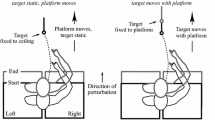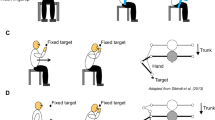Abstract.
The performance of a standing reaching task that necessitates some forward bending requires: (1) the coordination of multiple joints (i.e., the trunk and limb segments) to reach the target, and (2) the preservation of postural stability. It has been proposed that the neural control of multijoint reaching tasks can be simplified by time scaling of joint motions while keeping joint excursions the same. To determine if time scaling of joint motions was used in this more complex reaching task, we had 20 healthy subjects (10 male and 10 female) reach for two targets located in a parasagittal plane while standing on a force platform. Subjects reached for the targets at a comfortable speed and a fast paced speed. Sagittal plane motions of the right shank, thigh, pelvis, trunk, humerus, and forearm were measured. At the fast paced movement speeds subjects had significantly larger excursions of the thigh, pelvis, humerus, and forearm compared to the comfortable speed. Thus, segment motions are not simply time scaled for standing multijoint reaches. We explored three possible reasons for not obeying time scaling: (1) to reduce scaling of peak kinetic energy, (2) to reduce scaling of peak horizontal ground reaction force, and (3) a convergence of movement strategies at faster speeds. While subjects modified their movement strategy in relationship to movement speed, these changes had no significant effect on the expected scaling of peak kinetic energy, or peak horizontal ground reaction forces. Given the intersubject differences in movement strategies used to perform these reaching tasks at the fast speeds, a convergence of movement strategies was ruled out. We propose that the increase in segment motions with speed may be a consequence of rules underlying motor output, the increases being greater for segments in which viscoelastic resistance to movement is more significant compared to inertial resistance.
Similar content being viewed by others
Author information
Authors and Affiliations
Additional information
Electronic Publication
Rights and permissions
About this article
Cite this article
Thomas, J.S., Corcos, D.M. & Hasan, Z. Effect of movement speed on limb segment motions for reaching from a standing position. Exp Brain Res 148, 377–387 (2003). https://doi.org/10.1007/s00221-002-1287-2
Received:
Accepted:
Issue Date:
DOI: https://doi.org/10.1007/s00221-002-1287-2




